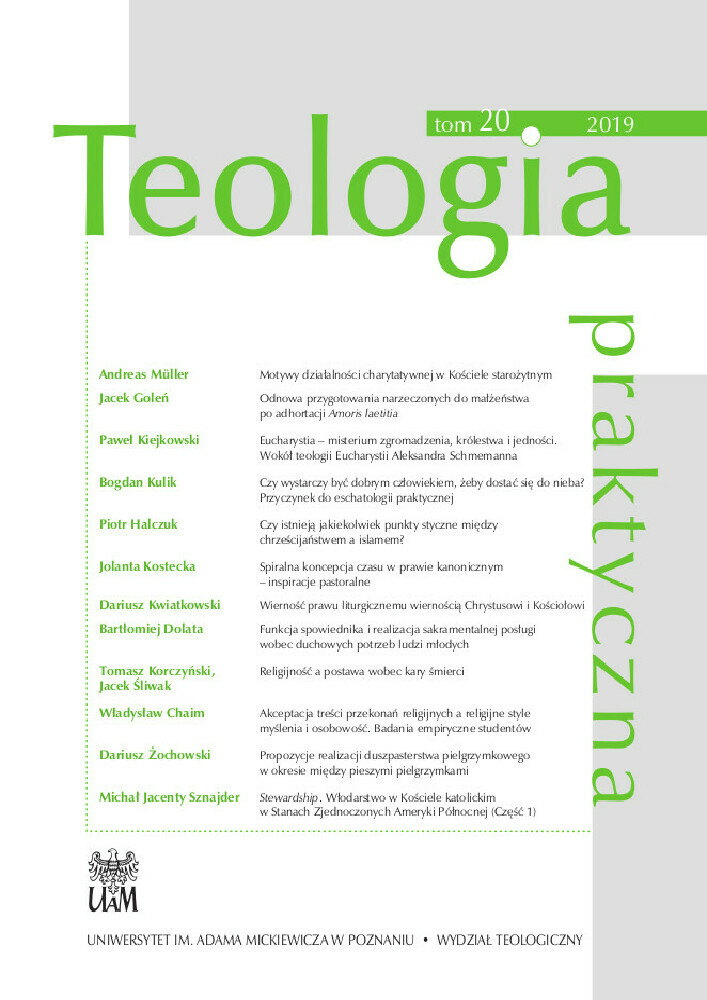Abstract
In the article the author proposes the analysis of theoretical and practical aspects of a spiral theory of the time. In the fi rst part she explains the meaning of the terms: time and eternity, afterwards she elaborates the structure of the spiral conception of the time. Consecutive parts of the article refer to temporal aspects in law, the time in the light of the Catholic Church’s knowledge and theology (the perspective of eternity) and applications of the spiral conception of time in provisions of the ecclesiastical law. This conception of time connects circular and linear theories of time. The canon law legislator uses the spiral conception of time and lays down legislative acts which should contribute to the regaining the meaning of life – eternity. It is important to help people take good care of how they live and spend their time in order to transform chronos into kairos. The contemporary problem of a continuous lack of time is becoming more pressing. Living in a great hurry and fear of death are connected with loss of the perspective of eternity. In view of the above, the author draws the conclusion that kairos is a time that gives hope, a time that gives a chance to overcome crisis and to start over, making use of the previous experiences, getting back on to some occurrences, but experiencing them in a spiral growth, being on a new, superior stage of advancement. The author also pays attention to Catholic mission’s domination and canon law’s subordination. The pursuit of eternity requires ceaseless progress and growing in Christian perfection.
References
Augustyn (2013): Wyznania. Tłum. W. Kubiak. Kraków.
Bielecki S. (1999): Chrześcijanin i czas według Listów św. Pawła. Jak rozumieć Pismo Święte? (11). Lublin.
Czas (2006). W: S. Dubisz, L. Drabik, E. Sobol (red.), Uniwersalny słownik języka polskiego PWN t. 1 s. 508-509.Warszawa.
Człowiekowska J. (2011): Czas w materialnym prawie administracyjnym. W: J. Zimmermann (red.), Czas w prawie administracyjnym s. 80-98. I Krakowsko-Wrocławskie Spotkanie Naukowe Administratywistów. Warszawa.
Dziewiecki M. (2005): Komunikacja pastoralna. Kraków.
Fuliński A. (2004): Czas i problemy pokrewne. W: J.A. Janik (red.), Nauka – Religia – Dzieje. XII Seminarium w Castel Gandolfo 5-7 sierpnia 2003. Czas – Wieczność – Nieskończoność s. 89--95. Kraków.
Gadacz T. (2002): Czas. W: D. Kalisiewicz (red.), Wielka encyklopedia PWN t. 6 s. 321. Warszawa.
Jan Paweł II (1994): List apostolski Tertio millennio adveniente. http://nauczaniejp2.pl/dokumenty/wyswietl/id/806.
Jaskiernia J. (2004): Kontekst czasu w prawie konstytucyjnym. W: A. Wierciński (red.), The Peculiarity of Man Vol. 9. O naturze czasu s. 341-353. Kielce–Warszawa.
Konecki K (2014): Czas z Chrystusem. Rok liturgiczny. Włocławek.
Nowacki J., Tobor Z. (1994): Wstęp do prawoznawstwa. Warszawa.
Pawluk T. (1985): Prawo kanoniczne według Kodeksu Jana Pawła II. T. 1. Zagadnienia wstępne i normy ogólne. Olsztyn.
Rusiecki J. (2012): Koncepcje czasu a liturgia. W: J. Nowak (red.), Misterium Chrystusa w roku liturgicznym. Księga pamiątkowa dedykowana Księdzu Profesorowi Bogusławowi Nadolskiemu TChr z okazji 55-lecia Święceń Kapłańskich i 50-lecia pracy naukowej s. 41-50. Poznań.
Sobeczko H. (2010): Liturgia – liturgika – mistagogia. W: C. Krakowiak, W. Przygoda, A. Kiciński, M. Wyrostkiewicz (red.), Teologia pastoralna nauką w służbie nowej ewangelizacji s. 63-84. Lublin.
Stinissen W. (1997): Wieczność pośrodku czasu. Poznań.
Świerzawski W.J. (2004): Rok liturgiczny naszą drogą z Chrystusem. Duchowość Eucharystyczna. Sandomierz.
Wasilewski A. (1966): Upływ czasu jako zdarzenie prawne w prawie administracyjnym. „Państwoi Prawo” 1:1966 s. 57-66.
Wronkowska S. (2005): Podstawowe pojęcia prawa i prawoznawstwa. Poznań.
License
Autorzy
Autorzy tekstów przyjętych do publikacji w czasopiśmie Teologia Praktyczna są zobowiązani do wypełnienia, podpisania i odesłania na adres redakcji umowy o udzielenie nieodpłatnej licencji do utworów, z zobowiązaniem do udzielania sublicencji CC.
Zgodnie z umową, autorzy tekstów opublikowanych w czasopiśmie Teologia Praktyczna udzielają Uniwersytetowi im. Adama Mickiewicza w Poznaniu niewyłącznej i nieodpłatnej licencji oraz zezwalą na użycie sublicencji Creative Commons Attribution-NoDerivatives 4.0 International (CC BY-ND 4.0).
Autorzy zachowują prawa do dalszego, swobodnego rozporządzania utworem.
Użytkownicy
Zainteresowani użytkownicy internetu uprawnieni są do korzystania z utworów opublikowanych od 2015 roku w Teologii Praktycznej pod następującymi warunkami:
- uznanie autorstwa - obowiązek podania wraz z rozpowszechnionym utworem, informacji, o autorstwie, tytule, źródle (odnośniki do oryginalnego utworu, DOI) oraz samej licencji;
- bez tworzenia utworów zależnych - utwór musi być zachowany w oryginalnej postaci, nie można bez zgody twórcy rozpowszechniać np. tłumaczeń, opracowań.
Do wszystkich tekstów opublikowanych przed 2015 r. prawa autorskie są zastrzeżone.
Inne
Uniwersytet im. Adama Mickiewicza w Poznaniu zachowuje prawo do czasopisma jako całości (układ, forma graficzna, tytuł, projekt okładki, logo itp.).

